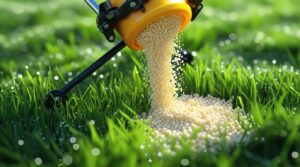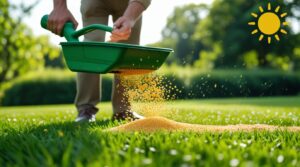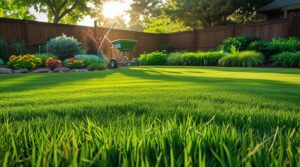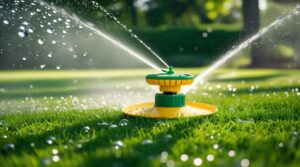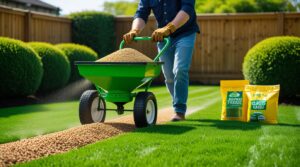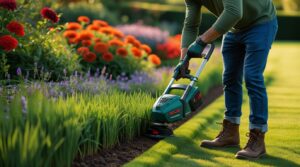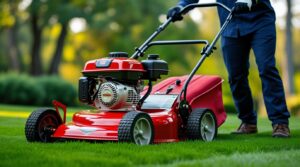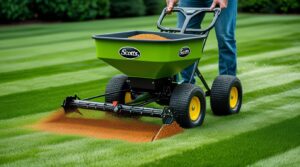The secret to a lush, green lawn isn’t just about choosing the right fertilizer—it’s all about consistency. And that’s where a smart lawn irrigation system makes all the difference. While manual watering can be time-consuming, uneven, and wasteful, automated irrigation ensures your grass gets the exact amount of water it needs, right when it needs it.
A lawn irrigation system is a setup of strategically placed sprinklers, hoses, or drip lines that automates the watering process across your yard. These systems range from simple timers to high-tech smart controllers that adjust to weather conditions in real-time.
More and more homeowners are ditching the garden hose and embracing automated watering—not just for convenience, but to save water, reduce utility bills, and maintain healthier lawns year-round. Whether you have a small backyard or a sprawling front lawn, the right system can take your yard from dry and patchy to thriving and vibrant.
In this complete guide, we’ll explore the types of irrigation systems, their key benefits, how to install and maintain them, and which products are worth your investment. Let’s dive in and take the guesswork out of watering your lawn!
What Is a Lawn Irrigation System?
A lawn irrigation system is a method of watering your yard automatically through a network of underground pipes, sprinkler heads, valves, and timers. Instead of dragging around a hose or guessing how much water your lawn needs, an irrigation system delivers water evenly and efficiently—no overwatering, no dry patches.
Here’s how it works: water flows from your home’s main supply into underground pipes that are connected to zones throughout your yard. Each zone is equipped with sprinkler heads or drip emitters that pop up or activate when it’s time to water. A timer or smart controller manages when and how long each zone runs, often based on weather data or preset schedules.
The beauty of a lawn irrigation system lies in its automation. It saves you time, conserves water, and ensures your lawn receives consistent hydration. Whether you’re at home or on vacation, your lawn stays green and healthy with minimal effort.
Perfect for busy homeowners or anyone aiming for a professional-looking yard, irrigation systems bring convenience and consistency to your lawn care routine.
Benefits of a Lawn Irrigation System
Installing a lawn irrigation system isn’t just about convenience—it’s a smart investment in the health of your lawn and the value of your home. One of the biggest advantages is water conservation. With scheduled watering times and zone-specific control, these systems deliver the right amount of water exactly where it’s needed, reducing waste and lowering your utility bills.
By eliminating the guesswork, a lawn irrigation system helps prevent both overwatering and underwatering—two common issues that can harm grass, encourage weeds, or lead to fungal growth. The result? A consistently green, vibrant, and resilient lawn all season long.
Beyond aesthetics, a well-maintained lawn significantly boosts curb appeal and can even increase your property’s value. Potential buyers love the idea of a low-maintenance, self-sustaining yard.
For eco-conscious homeowners, automated irrigation also supports sustainable landscaping. Many modern systems include rain sensors, soil moisture detectors, and smart controllers that adjust based on local weather conditions, ensuring your lawn is cared for responsibly.
In short, whether you’re saving time, saving water, or saving your lawn from stress, a lawn irrigation system delivers value on every front.
Different Types of Lawn Irrigation Systems
Choosing the right lawn irrigation system depends on your yard’s size, shape, and watering needs. Below are the most popular types of systems, each designed to suit different lawn and garden layouts.
A. Sprinkler Systems
Sprinkler systems are the most common choice for residential lawns. These systems use pop-up, rotor, or impact sprinkler heads to spray water evenly across a wide area.
- Pop-up sprinklers: Retract into the ground when not in use—great for maintaining a clean, unobstructed lawn look.
- Rotor sprinklers: Spin to distribute water slowly over a large area, making them perfect for medium to large lawns.
- Impact sprinklers: Known for their ticking sound and high durability, they’re ideal for rougher terrain and broader coverage.
Top Recommendation:
✅ Orbit Voyager II – Great for rotor coverage and adjustability.
✅ Rain Bird 1804 Pop-Up – Trusted for smaller to mid-size lawns.
B. Drip Irrigation
Drip irrigation systems deliver water directly to the root zone through a network of tubing and emitters. This method drastically reduces water waste and evaporation.
- Best suited for flower beds, shrubs, and narrow lawn strips.
- Minimizes water on leaves and stems, reducing disease risk.
Top Recommendation:
✅ Raindrip R560DP Automatic Drip Kit – Beginner-friendly and expandable.
C. Soaker Hoses
Soaker hoses are an affordable and easy-to-install solution that slowly release water along their length through tiny pores.
- Excellent for garden beds, hedges, and small lawn areas.
- Lay them directly on the soil or beneath mulch for efficient watering.
Top Recommendation:
✅ Melnor Flat Soaker Hose – Flexible, durable, and ideal for tight spaces.
D. Smart Irrigation Systems
Smart irrigation systems connect to Wi-Fi and monitor weather data, soil conditions, and schedules for optimal watering.
- Control your system from anywhere using your smartphone.
- Great for water conservation and modern convenience.
Top Recommendation:
✅ Rachio 3 Smart Sprinkler Controller – Weather Intelligence™ and app control.
✅ Orbit B-hyve Smart 8-Zone Timer – Budget-friendly with great features.
Whether you’re managing a small backyard or a sprawling front lawn, there’s a lawn irrigation system built to meet your needs. The right choice will save water, save time, and keep your lawn looking its best.
How to Choose the Right Irrigation System
With so many options available, choosing the perfect lawn irrigation system for your yard comes down to understanding your landscape’s unique needs. Here’s what you should consider before investing:
Lawn Size and Shape
Larger or oddly shaped lawns may benefit from rotor sprinkler systems or smart irrigation with zoned controls. Compact areas or garden beds? Drip systems or soaker hoses are usually more efficient.
Soil Type and Drainage
Sandy soils drain quickly and may require more frequent watering, while clay soils hold moisture longer. A system with adjustable flow rates or smart scheduling can help match your lawn’s water absorption rate.
Climate and Rainfall
If you live in a dry climate, opt for systems with moisture sensors and efficient delivery (like drip irrigation). In wetter areas, smart irrigation systems with rain skip technology can help avoid overwatering.
Budget
Soaker hoses and basic timers are low-cost options for small spaces. On the higher end, smart controllers and underground systems require a bigger upfront investment but offer long-term savings on water bills.
DIY vs Professional Installation
Simple systems like soaker hoses or surface-level sprinklers are easy to DIY. For underground piping, zoning, or smart tech integration, it may be wise to hire a professional to avoid costly errors.
Ultimately, the best lawn irrigation system is the one that fits your landscape, lifestyle, and budget. Take the time to evaluate your needs before buying—you’ll thank yourself later.
Step-by-Step Installation Guide for a Lawn Irrigation System
Installing your lawn irrigation system might sound intimidating, but with the right plan and tools, it’s doable for DIYers. Here’s a simplified step-by-step guide to help you get started:
1. Planning and Zoning
Start by sketching your yard. Divide it into zones based on sun exposure, plant types, and slope. Each zone will need its own set of sprinkler heads or drip lines to ensure even watering.
2. Materials Checklist
You’ll need:
- PVC or polyethylene pipes
- Sprinkler heads or drip emitters
- Valves and fittings
- Backflow preventer
- Timer/controller
- Pipe cutter
- Teflon tape, glue, and stakes
3. Digging and Laying
Use a trenching shovel to dig shallow trenches (6–12 inches deep). Lay the pipes following your plan, connecting them with elbows and tees to reach each zone.
4. Connecting Components
Attach sprinkler heads or drip emitters at the designated spots. Install the backflow preventer and connect your main water supply. Use proper sealant for watertight connections.
5. Installing the Timer/Controller
Mount the timer near a water source or power supply. Program the system based on your lawn’s needs—most timers allow daily, weekly, or even moisture-based scheduling.
6. Testing and Troubleshooting
Turn on the system and check for leaks, uneven spray patterns, or clogged heads. Make necessary adjustments before covering the trenches.
With the right tools and guidance, setting up a lawn irrigation system can be a rewarding weekend project that pays off all season long.
Maintenance & Seasonal Care Tips
To get the most out of your lawn irrigation system, regular maintenance is a must. A well-maintained system ensures consistent performance, extends the life of your components, and helps you avoid costly repairs down the line.
Inspect for Clogs and Leaks
Start by checking sprinkler heads and drip emitters for clogs, especially if you notice dry patches or uneven watering. Leaks can occur at fittings or valves—watch for pooling water or a sudden drop in pressure.
Adjust Seasonally
Your lawn irrigation system needs different settings in spring, summer, and fall. In spring, gradually reactivate your system by turning the water back on slowly to prevent damage from pressure surges. In colder climates, be sure to winterize before the first freeze by draining pipes and blowing out residual water with an air compressor.
Replace Worn Components
Nozzles and heads can wear out or get damaged over time. Replace them if you see inconsistent spray patterns or physical cracks. Also, check for broken risers or cracked fittings after mowing or heavy foot traffic.
Clean Filters and Check Valves
Drip systems and timers often have filters that catch debris. Clean these regularly to prevent blockage. Inspect backflow preventers and valves to ensure water flows correctly and safely.
With just a bit of seasonal upkeep, your lawn irrigation system will stay in top shape, keeping your grass green and your weekends worry-free.
Smart Irrigation Systems – Are They Worth It?
If you’re the kind of homeowner who loves convenience and tech-driven solutions, a smart lawn irrigation system might be exactly what you need. These systems use sensors, real-time weather data, and soil moisture readings to adjust watering schedules automatically, so you’re not watering in the rain or over-soaking your lawn during cooler days.
The biggest perks? You can control everything from your phone. Whether you’re on vacation or just lounging on the couch, you can start, stop, or reschedule watering with a tap. Smart systems also help cut down on water waste by watering only when your lawn actually needs it.
Here’s a quick comparison of the top-rated smart irrigation systems:
| Brand | Key Feature | Best For |
| Rachio 3 | Weather Intelligence™ + Alexa compatible | Smart home integration |
| RainMachine Touch HD | Touchscreen & Wi-Fi control | Detailed manual scheduling |
| Orbit B-hyve | Budget-friendly + weather-based programming | Cost-conscious homeowners |
While the upfront cost is a bit higher, a smart lawn irrigation system pays off in long-term savings, convenience, and lawn health. It’s automation at its best—for your yard.
Cost Breakdown: Installation, Operation & ROI
Before installing a lawn irrigation system, it’s important to weigh the upfront costs against the long-term value. Whether you go the DIY route or hire a professional can make a big difference in your initial investment.
DIY vs Professional Installation
A basic DIY system with hoses, timers, and above-ground sprinklers can cost anywhere from $100 to $500, depending on lawn size. Underground systems require more effort and materials, but are still doable for experienced DIYers.
Hiring a professional for a full in-ground lawn irrigation system typically costs between $1,500 and $3,500, depending on your yard’s complexity, local labor rates, and the type of system you choose.
Savings & Long-Term Value
Smart and efficient irrigation can cut your water bill by 30–50%, especially in areas where lawns need frequent watering. Add in the benefit of time savings and lower lawn maintenance costs, and it’s clear why many homeowners see this as a worthwhile investment.
Plus, a well-designed irrigation system enhances curb appeal and can boost your property value—an attractive selling point if you ever put your home on the market.
In short, a lawn irrigation system may cost upfront, but it pays you back every season.
Common Lawn Irrigation Mistakes to Avoid
Watering your lawn might seem simple—turn on the sprinkler and let it run. But improper irrigation is one of the most common reasons lawns suffer from brown spots, weed invasion, and poor growth. Avoiding a few key mistakes can help you maintain a lush, green lawn while saving water and money.
1. Overwatering or Wrong Timing
When it comes to lawn care, water is essential, but too much or mistimed watering can do more harm than good. Overwatering and watering at the wrong time are two of the most common mistakes homeowners make, often leading to weak roots, fungal disease, and wasted water.
Let’s break down why these mistakes are harmful—and how to avoid them.
The Problem with Overwatering
Giving your lawn too much water may seem harmless, but it causes serious issues:
-
Shallow root growth: Roots stay near the surface and can’t access deep soil nutrients or withstand drought.
-
Fungal growth: Constant moisture creates a breeding ground for fungi like brown patch, dollar spot, and rust.
-
Nutrient leaching: Excess water washes away vital nutrients before your grass can absorb them.
-
Weed invasion: Weeds like crabgrass thrive in moist, poorly drained soil.
Smart Watering Tips:
-
Water deeply but infrequently—1 to 1.5 inches per week is usually enough.
-
Use a moisture meter or soil probe to check if your lawn actually needs water.
-
If the soil feels moist 3–4 inches down, skip watering for the day.
The Importance of Timing
Watering at the wrong time—especially late in the evening or midday—can lead to serious lawn problems:
Why Timing Matters:
-
Midday watering leads to rapid evaporation, wasting water before it reaches the roots.
-
Evening watering leaves the lawn damp overnight, encouraging mold and fungus.
Best Time to Water:
-
Early morning (4 a.m. to 10 a.m.) is ideal.
-
Cooler temperatures allow water to soak in.
-
Sunlight dries excess moisture, reducing disease risk.
-
Don’t let your good intentions backfire. Overwatering and poor timing are silent killers of lawn health. By adjusting your watering habits, you can grow a greener, stronger, and more drought-resistant lawn—while using less water.
2. Poor Sprinkler Head Placement
You may be watering your lawn regularly, but if your sprinkler heads aren’t placed properly, parts of your lawn could be overwatered, underwatered, or even neglected completely. Poor sprinkler head placement is a surprisingly common mistake that leads to patchy grass, water waste, and higher utility bills.
Let’s break down the signs, causes, and solutions.
Signs of Poor Sprinkler Head Placement
-
Dry or brown patches in random areas
-
Overwatered spots that feel soggy or have standing water
-
Water spraying on sidewalks, driveways, or fences
-
Uneven lawn growth despite consistent watering
What Causes Poor Placement?
-
Incorrect spacing between sprinkler heads
-
Sprinklers blocked by tall grass, landscape features, or objects
-
Misaligned heads that spray off-target or overlap unevenly
-
Using the wrong type of sprinkler head for your lawn layout
How to Fix Sprinkler Placement Issues
1. Check for Head-to-Head Coverage
Sprinklers should be spaced so that each one sprays water just far enough to reach the next. This ensures even coverage without dry gaps.
2. Adjust Spray Direction & Angle
Manually adjust the nozzles to point in the correct direction. Avoid spraying hard surfaces.
3. Use the Right Nozzles
Choose fixed spray heads for small, defined areas and rotary heads for larger zones. Specialty nozzles are available for corners and irregular areas.
4. Inspect for Obstructions
Make sure heads aren’t blocked by shrubs, turf, or debris. Trim around them regularly.
5. Upgrade to Smart Irrigation
Smart systems like the Rachio 3 Smart Sprinkler Controller can help automate and optimize watering schedules based on actual coverage and weather conditions.
Even if you’re watering the right amount at the right time, poor sprinkler head placement can ruin your lawn’s health and waste water. A quick inspection and a few small adjustments can make a huge difference in coverage, efficiency, and results.
3. Skipping Maintenance
You’ve installed a sprinkler system, set a schedule, and let it run. But what happens when you skip routine maintenance? Ignoring sprinkler maintenance is one of the most overlooked mistakes in lawn irrigation—and it can lead to uneven watering, water waste, equipment damage, and even a dying lawn.
Let’s explore why regular maintenance is essential and how to keep your irrigation system in peak shape.
What Happens When You Skip Irrigation Maintenance?
-
Wasted Water
Leaky pipes or misaligned sprinkler heads can waste hundreds of gallons per month. -
Uneven Lawn Coverage
Clogged nozzles and low pressure cause dry spots, while other areas may become oversaturated. -
Increased Utility Bills
Water that doesn’t reach your lawn effectively still shows up on your water bill. -
System Failure Over Time
Unattended small issues can turn into costly repairs or full replacements later.
Common Maintenance Issues to Watch For
-
Leaking valves or cracked pipes
-
Broken or missing sprinkler heads
-
Clogged nozzles from dirt or hard water buildup
-
Heads are not popping up or retracting properly
-
Spray patterns blocked by grass or debris
Easy Maintenance Checklist
Here’s how to stay ahead of irrigation problems:
1. Inspect Monthly
-
Walk your lawn while the system is running.
-
Check for pooling, dry patches, or unusual spraying.
2. Clean Sprinkler Heads
-
Remove and rinse nozzles to prevent clogging.
-
Use a soft brush to clear mineral buildup.
3. Adjust Head Position
-
Ensure nozzles are aimed correctly and are not spraying sidewalks or fences.
4. Check Water Pressure
-
Low or high pressure can cause damage and affect coverage.
-
Install a pressure regulator if needed.
5. Test Before Each Season
-
Before spring, run a full system check.
-
In fall, winterize your system to prevent freeze damage (especially in cold climates).
Skipping irrigation maintenance may seem harmless in the short term, but over time, it leads to brown patches, wasted water, and expensive repairs. Just a few minutes of inspection each month can protect your lawn and your wallet.
Not Adjusting for Rain
Rain is nature’s irrigation system—free, effective, and essential. But many homeowners still let their sprinklers run right after (or even during) rainfall. Failing to adjust your irrigation schedule for rainy weather not only wastes water and money, but it can also harm your lawn.
Let’s explore why this mistake happens, what it causes, and how to fix it with smart solutions.
Why It’s a Problem
-
Overwatering Stress: Natural rain combined with scheduled watering drowns the roots, causing yellowing, fungus, and poor root development.
-
Wasted Resources: You’re literally pouring money down the drain in the form of excess water usage.
-
Runoff and Erosion: Saturated lawns can’t absorb more water, leading to runoff that erodes soil and carries away nutrients.
Common Causes
-
Using manual sprinkler timers without weather awareness
-
Forgetting to turn off sprinklers when it rains
-
No rain sensor or smart irrigation controller installed
-
Assuming light rain isn’t enough to affect the watering schedule
Simple Fixes to Avoid Overwatering After Rain
1. Install a Rain Sensor
A rain sensor automatically shuts off your sprinkler system when rainfall is detected. Many states even require them by law for new irrigation systems.
✅ Recommended: Orbit Wireless Rain/Freeze Sensor — Easy to install and compatible with most controllers.
2. Use a Smart Controller
Smart irrigation controllers use real-time weather data to adjust your schedule. Some even skip watering if rain is forecasted.
✅ Recommended: Rachio 3 Smart Sprinkler Controller — Adjusts watering based on hyperlocal weather.
3. Check the Forecast Weekly
If you’re using a manual system, make it a habit to check the weather and pause watering after 0.25″ or more of rainfall.
4. Install a Soil Moisture Sensor
These devices can detect when your lawn is already moist and automatically delay watering.
❓ FAQs About Lawn Irrigation Systems
How often should I water my lawn?
Most lawns need about 1 to 1.5 inches of water per week, including rainfall. It’s better to water deeply 1–2 times a week rather than lightly every day. This encourages stronger root growth.
Can I install an irrigation system myself?
Yes—many homeowners successfully install DIY lawn irrigation systems, especially above-ground or simple drip setups. However, for in-ground systems with multiple zones and timers, professional installation ensures proper layout, pressure regulation, and long-term durability.
What’s the best system for a sloped yard?
Drip irrigation is ideal for sloped areas because it delivers water slowly at the soil level, reducing runoff. Sprinklers can work too, but it’s crucial to use lower flow heads and stagger watering times.
Is drip irrigation better than sprinklers?
It depends on your needs. Drip irrigation is more water-efficient and ideal for garden beds, hedges, and oddly shaped areas. Sprinkler systems are better for wide, open lawns. Many homeowners use a combination of both for optimal coverage.
How much does a smart irrigation system save?
Smart systems can cut water usage by 30% or more, especially when paired with weather sensors and efficient scheduling. Over time, that means lower water bills and a more sustainable lawn care routine.
Have more questions about the best lawn irrigation system for your yard? Keep reading—or check out our top product picks and installation tips!
Final Thoughts
If you’re aiming for a greener, healthier yard without the hassle, a lawn irrigation system is a smart move. It offers consistent watering, saves you time, conserves water, and gives your lawn the lush look you’ve always wanted—all with minimal effort.
Whether you’re a DIY enthusiast or prefer tech-driven solutions, there’s a system out there to match your needs. Start small with an entry-level soaker hose or go high-tech with a smart irrigation controller that does all the thinking for you.
Before buying, consider your lawn size, layout, and watering goals. With the right setup, your yard can thrive, season after season.
Ready to transform your lawn? Explore the best lawn irrigation systems today!


